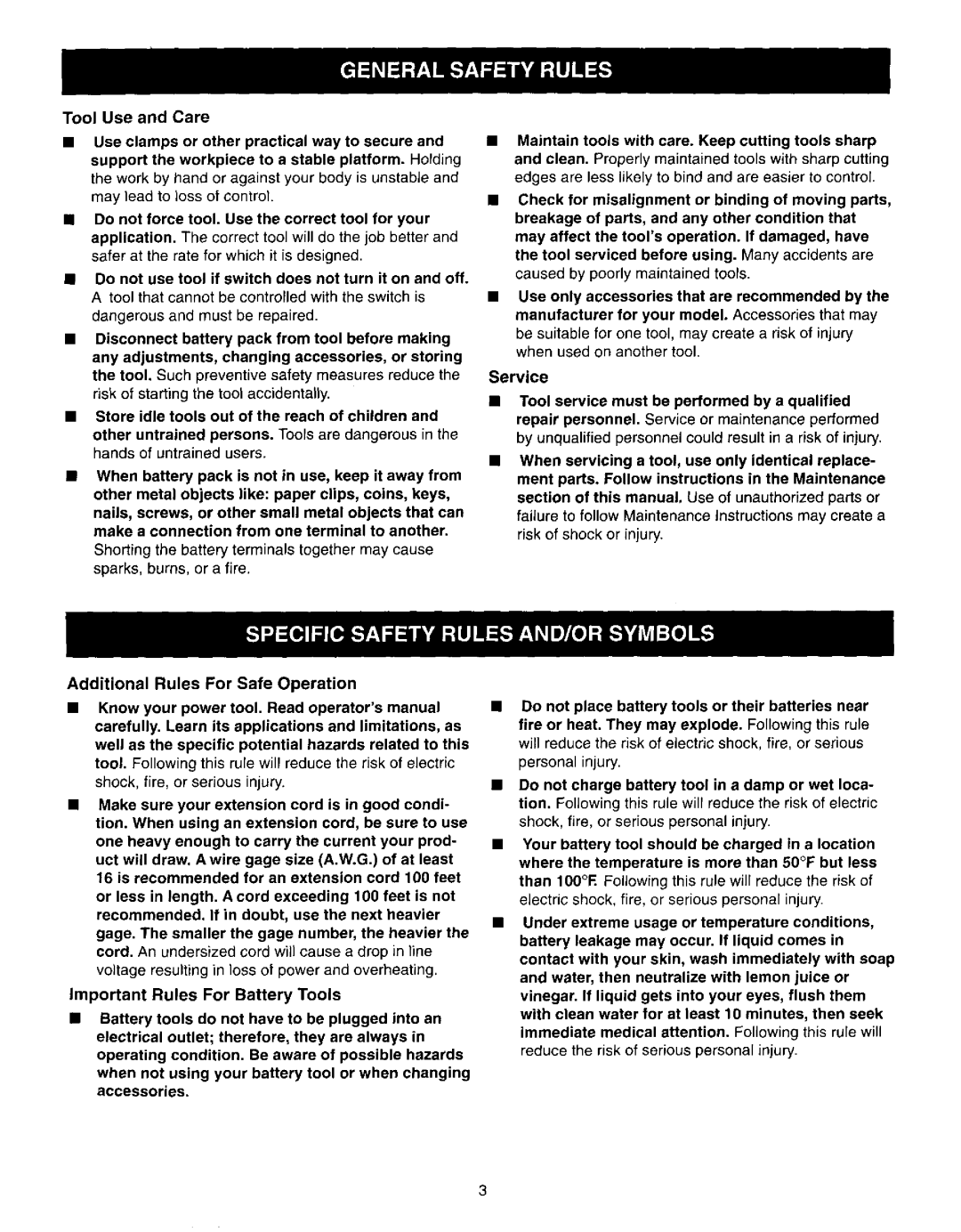
Tool Use and Care
•Use clamps or other practical way to secure and support the workpiece to a stable platform. Holding the work by hand or against your body is unstable and may lead to loss of control.
•Do not force tool. Use the correct tool for your application. The correct tool will do the job better and safer at the rate for which it is designed.
•Do not use tool if switch does not turn it on and off. A tool that cannot be controlled with the switch is dangerous and must be repaired.
•Disconnect battery pack from tool before making any adjustments, changing accessories, or storing
the tool. Such preventive safety measures reduce the risk of starting the tool accidentally.
•Store idle tools out of the reach of children and
other untrained persons. Tools are dangerous in the hands of untrained users.
•When battery pack is not in use, keep it away from other metal objects like: paper clips, coins, keys, nails, screws, or other small metal objects that can make a connection from one terminal to another.
Shorting the battew terminals together may cause
sparks, burns, or a fire.
•Maintain tools with care. Keep cutting tools sharp and clean. Properly maintained tools with sharp cutting edges are less likely to bind and are easier to control.
•Check for misalignment or binding of moving parts, breakage of parts, and any other condition that may affect the tool's operation. If damaged, have the tool serviced before using. Many accidents are caused by poorly maintained tools.
•Use only accessories that are recommended by the manufacturer for your model. Accessories that may be suitable for one tool, may create a risk of injury when used on another tool.
Service
•Tool service must be performed by a qualified repair personnel. Service or maintenance performed by unqualified personnel could result in a risk of injury.
•When servicing a tool, use only identical replace- ment parts. Follow instructions in the Maintenance section of this manual. Use of unauthorized parts or failure to fellow Maintenance Instructions may create a risk of shock or injury.
Additional Rules For Safe Operation
Know your power tool. Read operator's manual carefully. Learn its applications and limitations, as well as the specific potential hazards related to this tool. Following this rule will reduce the risk of electric shock, fire, or serious injury.
Make sure your extension cord is in good condi- tion. When using an extension cord, be sure to use one heavy enough to carry the current your prod- uct will draw. A wire gage size (A.W.G.) of at least
16 is recommended for an extension cord 100 feet or less in length. A cord exceeding 100 feet is not recommended. If in doubt, use the next heavier gage. The smaller the gage number, the heavier the cord. An undersized cord will cause a drop in line voltage resulting in loss of power and overheating.
Important Rules For Battery Tools
Battery tools do not have to be plugged into an electrical outlet; therefore, they are always in operating condition. Be aware of possible hazards
when not using your battery tool or when changing accessories.
•Do not place battery tools or their batteries near fire or heat. They may explode. Following this rule will reduce the risk of electric shock, fire, or serious personal injury.
•Do not charge battery tool in a damp or wet loca- tion. Following this rule will reduce the risk of electric shock, fire, or serious personal injury.
•Your battery tool should be charged in a location where the temperature is more than 50°F but less than 100°R Following this rule will reduce the risk of electric shock, fire, or serious personal injury.
•Under extreme usage or temperature conditions, battery leakage may occur. If liquid comes in contact with your skin, wash immediately with soap and water, then neutralize with lemon juice or vinegar. If liquid gets into your eyes, flush them with clean water for at least 10 minutes, then seek immediate medical attention. Following this rule will reduce the risk of serious personal injury.
3
